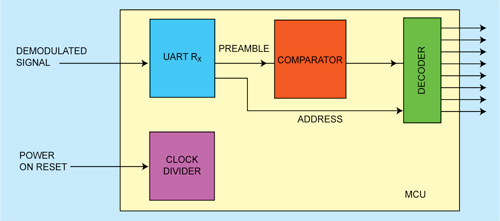As shown in Fig. 1, the drug-delivery chip is mounted on board. The PCB is further stacked on a Li-ion nanowire battery, which has high-density charge storage and is rechargeable. A planar inductor on the bottom of the package is used to receive the command signal and the wireless power from command OOK transmitter outside the body. The received power can be stored in the Li-ion battery, for a longer device lifetime. The drug-delivery device is implanted subcutaneously due to signal attenuation in the human body and limited size of the coupling inductor.
Drug reservoir fabrication
The drug-delivery SoC is fabricated by standard CMOS process followed by post-IC processing. After receiving the standard silicon chip with metal electrodes from the foundry, post-IC micromachining is applied to each of the reservoir structures.
First, the standard chip is thinned to 100 μm by mechanical lapping of the substrate. Then photolithography is performed on the back side of the chip to define the positions and sizes of reservoirs. After hard baking the photoresist as the etching blocking layer, the unblock area is trenched by inductively-coupled ion-enhanced plasma etching (ICP) to remove unwanted silicon, enabling formation of drug reservoir. Thereafter, silox vapour wet etching is done to remove the silicon dioxide filled between the electrodes. The electrodes thus exposed are now ready for electrolysis.
After back-side processing, post-IC processing is continued on front side. Passivation etching is done to create a thin capping layer of 200nm thickness in order to decrease the stiffness of the membrane. After this step, reservoirs complete with membrane and electrodes are formed, ready for drug filling.
Cross-section of the integrated reservoir is show in Fig. 3. In order to increase the reservoir volume capacity, a polydimethyl-siloxane (PDMS) layer is bonded on the back side of the chip. Each reservoir is 210 μm long and 110 μm wide.
After PDMS bonding, the reservoirs are filled with the designated drug by an automatic dispenser. A total of eight reservoirs are made with total die size of 1.77×1.4 mm2. By bonding PDMS layer, the capacity of drug reservoir is increased from 5 to 200 nl. Another PDMS film is used to seal the bottom of the reservoir after drug filling. The total thickness of the drug delivery SoC is 0.7 mm. The dose of the drug may be adjusted by controlling the number of opened reservoirs. The reservoirs are designed to be opened up one at a time according to the received command.
On-chip electrolysis
The releasing mechanism of the system is based on electrolysis. The metal electrodes are immersed in the aqueous solution of drug. By injecting currents from the lithium-ion battery, microbubbles of oxygen and hydrogen are generated due to the electrolysis reaction given below:
Anode: 2H2O→4H++4e–+O2 (gas)
Cathode: 2H2O+2e–→2OH–+H2 (gas)
Gases accumulate against the capping membrane until the membrane exceeds its rupture value (about 65 kPa)—a value when the membrane begins to rupture. Once the membrane ruptures, the drug is released. The lethal volume of air in an adult human is estimated to range from 200 to 300 ml. It is known that air bubbles of less than 30 μl dissolve harmlessly into the circulation. Since the volume of microbubbles generated by the device is about 120 nl—much smaller than 30 μl—the released bubble will not cause any health risk to the patient.
Sub-blocks of SoC
OOK receiver. Full integration and low power consumption are very important. Traditional direct-conversion and superheterodyne receivers consume a large amount of power and occupy a huge space. An alternative approach is adaptation of super-regenerative receiver and enveloped detection. Though this approach consumes less power, off-chip components, e.g., discrete inductor, bulk-acoustic-wave resonator and surface-acoustic-wave filter, occupy a huge space, posing a barrier to full system integration. Hence an envelope detection system based on the OOK receiver is adopted.
The envelope detection system based on the OOK receiver requires no off-chip components and on-chip inductor, enabling a reduction in size to 0.60 mm2. The OOK receiver comprises a low-voltage amplifier, an envelope detector and a comparator with an output buffer as shown in Fig. 2. A simple self-biasing technique and envelope detection take place in this circuit. Neither a frequency synthesiser nor biasing circuits are required. The carrier frequency centered at 402 MHz is designed to comply with the medical implant communication system regulation for data transmission and reception in the body.

MCU. The function of the MCU is simplified to the basic requirements, i.e., register number recognition release command check and switch array control. Fig. 4 shows the architecture of the MCU. It consists of a clock divider, a decoder, a comparator and a universal asynchronous receiver/transmitter receiver (UART Rx). The UART Rx demodulates the received signal, converts serial bits to a parallel form, and sends the same to the comparator and the decoder for further reaction.






